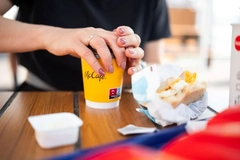Squeeze the day: Paper tube-pouch reduces plastic and waste in cosmetics

26 May 2020 --- Packaging and décor materials player Toppan Printing has developed a paper tube-pouch that reduces the use of plastic in cosmetics, toiletries and pharmaceuticals by over 50 percent. Moreover, the paper-based packaging allows consumers to fully squeeze out the product to avoid waste. The company says that the innovation boasts enhanced user-friendliness and reduced resource use, thus offering environmental benefits. The full-scale packaging launch is scheduled for this year in Japan.
Compared to the traditional type of laminated tube widely used for toothpaste, the tube-pouch uses thinner film material, making it easier to squeeze. The new paper tube-pouch maintains the functionality of plastic tube-pouches while demonstrating what is touted as better environmental performance by employing a paper-based material for the body, which reduces its plastic volume by half. Furthermore, the company has reduced plastic in the cap, reaching a total of 65 percent.
Although plastic has been replaced with paper, the tube-pouch still maintains its shape even when the volume of content inside decreases, and the use of Toppan’s proprietary GL Barrier film on the inner surface ensures the high barrier performance required for items such as food and cosmetics.
.jpg) The body of the paper tube-pouch has a thickness of just 0.1 mm and a folded structure. Combined with a horizontal design for the plastic spout, this makes it easier to completely squeeze out the contents. The use of paper for the exterior surface also means that design and sales promotion can fully exploit the advantages of the material’s feel and texture, making the paper tube-pouch effective in communicating more natural and organic product concepts to consumers.
The body of the paper tube-pouch has a thickness of just 0.1 mm and a folded structure. Combined with a horizontal design for the plastic spout, this makes it easier to completely squeeze out the contents. The use of paper for the exterior surface also means that design and sales promotion can fully exploit the advantages of the material’s feel and texture, making the paper tube-pouch effective in communicating more natural and organic product concepts to consumers.
“The paper tube-pouch represents a new solution that can meet the needs of manufacturers, consumers, and society as a whole by reducing impact on the environment, enhancing user-friendliness, and also offering new possibilities for design,” notes Shingo Wada, General Manager of Business Strategy in Toppan’s western Japan division.
“It is another example of Toppan’s efforts to tackle such issues as marine plastic and the need for efficient circulation of resources by developing eco-friendly packaging and containers that sacrifice nothing in terms of functionality while making use of more sustainable materials, such as recycled and biomass plastics, monomaterials, and paper,” he adds.
Eco-boost for cosmetic packaging
The personal care industry is increasingly making moves to improve the environmental sustainability of its packaging. A more eco-friendly profile is also more appealing to modern consumers. Recognizing this, L’Oréal’s brand La Roche-Posay achieved a global first by packaging its Anthelios sunscreen in a cardboard tube, starting this month in the French market. The cardboard tube solution reduces plastic usage by a reported 45 percent. The innovative tube is the result of L’Oréal’s collaboration with cosmetic packaging heavyweight Albéa and is the first in a long line of cardboard solutions to follow, according to the companies. Cosmetic specialist Kiehl is set to become the next brand to adopt the eco-friendly cardboard packaging solution in 2021.
L’Oréal first announced that it was working with Albéa to develop paper and cardboard packaging late last year. L’Oréal and Albéa share an awareness of their responsibilities as major industrial actors. The two companies are committed to the Ellen McArthur Foundation’s New Plastics Economy Global Commitment, which promotes a circular economy.
Urth Organic’s also launched packaging that boasts a greener profile. The brand’s cosmetic line now includes wooden caps and tops. The green colored containers with the wooden additions reflect the purity of ingredients within the formulations, according to the company.
Meanwhile, SOPO – an acronym for Stick-On, Pull-Off Dispensers – launched early this year, claiming to be the new personal care dispenser that promises to declutter bathroom countertops while using 70 percent less plastic in its packaging.
In other notable packaging solutions within personal care, Lifestyle Packaging designed a one-hand dispensing mechanism for alcohol-based hand sanitizer coined Snappd. The product is a brandable packaging innovation, developed to deliver a single dose solution with minimal contact when dispensing liquid. The launch comes as hand sanitizer production is skyrocketing due to the COVID-19 outbreak. According to the company, Snappd offers an even more sanitary solution than traditional plastic unit dose bottles, which can be touched by several people and contribute to the spread of bacteria and viruses.
Edited by Kristiana Lalou











